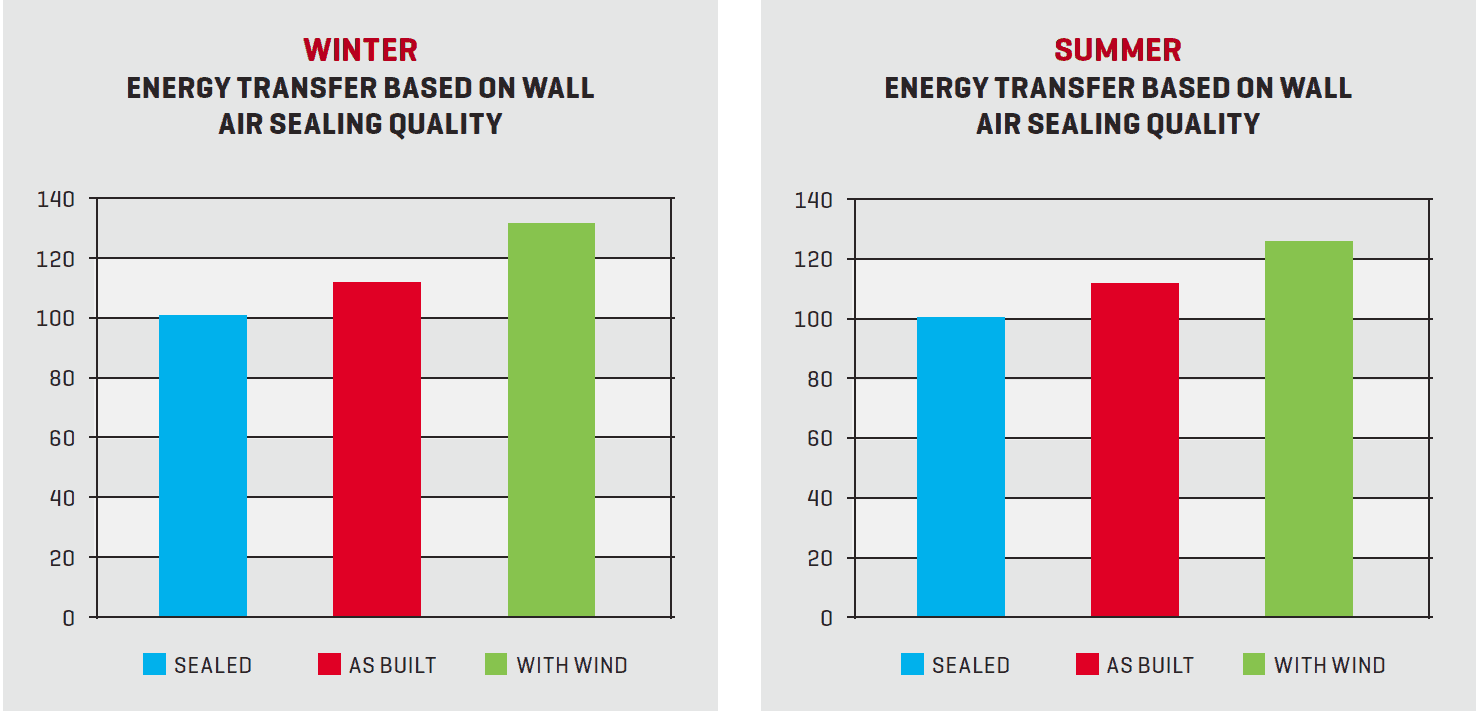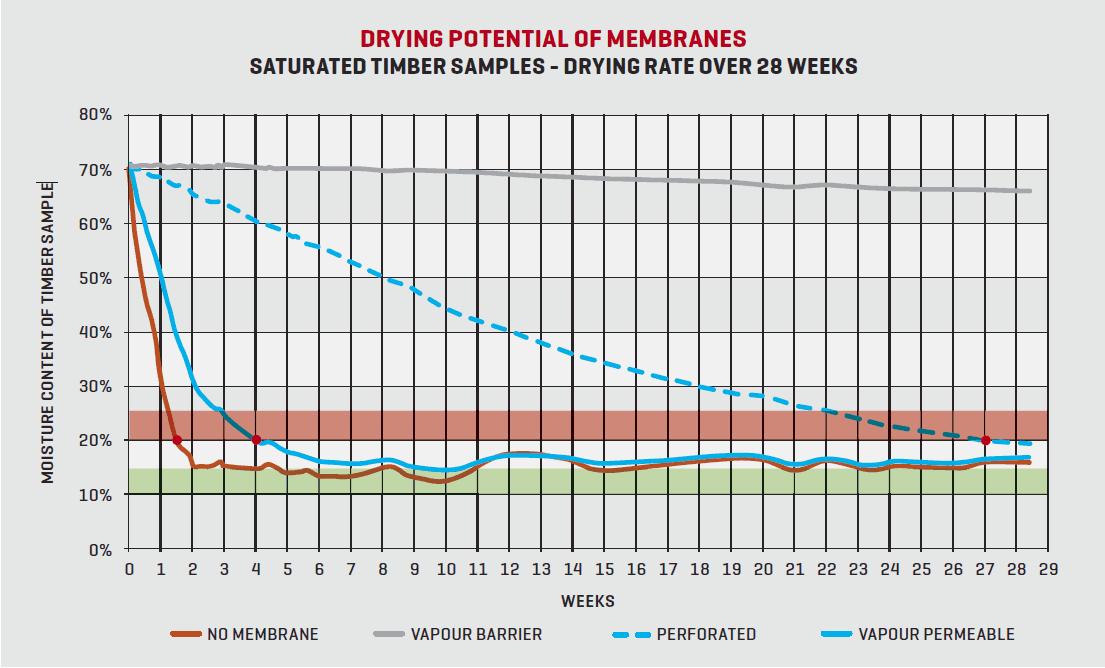The drying potential of membranes
Jesse Clarke, building scientist at CSR, discusses the idea of using vapour permeable membranes for moisture control in buildings.
In recent history, membranes have played two key roles when incorporated into the building structure: to enhance the thermal properties of construction systems and/or to act as a sarking to safely drain away unintended water leaks in the external cladding.
More recent innovations in the properties of membranes mean they are becoming an essential part of thermally efficient moisture resilient structures. Membranes now allow us to address issues in building structures which go far beyond reflective properties for radiant heat control and water barrier properties as a sarking function.
In 2013, the Building Science Corporation published that the heat transfer properties of all types of insulated walls are reduced by air movement through the construction. On average a built wall will transfer 12% more energy in winter and summer than a well-air-sealed wall.
When wind is taken into account 31% more energy will be transferred in winter and 26% more energy in summer. This raises the need for the use of air barrier membranes within a construction system to reduce the overall heat transfer through walls. This can be easily achieved by utilising a properly installed and taped wall wrap on the external side of the studwork.
In addition to the air barrier properties of membranes, the emittance or reflective properties of the membranes can be used to reduce the radiant heat transfer. The shiny or low emittance side of the membrane facing into a vacant air void will reduce the radiant heat transfer.
However, these radiant barrier properties are typically achieved using an aluminium foil layer on the surface of the membrane which almost completely eliminates any water vapour transfer properties of the membrane (with the exception of micro perforations).
Once air movement with wall cavities is controlled to a reasonable level to improve thermal performance then the key method of removing moisture away from the structure – air transportation of water vapour – has also being severely hindered.
This means that drying has to be attained through other methods and can be largely achieved by water vapour permeable materials. These materials allow water vapour to pass from one side of the membrane to the other. Foil layers in membranes will typically prevent any water vapour from escaping and are broadly called ‘vapour barriers’.
In the event that vapour barrier materials are used and the structure should happen to become wet then the chance of mould and rot issues in well-sealed and air tight assemblies is increased, the effects of which are shown in the images below.

Building air tight systems leaves only one mechanism for trapped moisture (water or water vapour) to escape. Vapour diffusion through the building materials surrounding the insulation layer becomes very important.
Traditionally, in Australia, we have built wall systems bounded by a vapour barrier on the outside of the studwork and plasterboard on the inside of the studwork. Little attention has been paid to the capacity of the membrane to allow moisture to escape to the outside; or the ability of the plasterboard and paint layers to allow the moisture to escape to the inside as shown below.
The resilience of the structure can be significantly increased by allowing water vapour to escape from the construction system using vapour permeable membranes on the outside of the studwork. Vapour permeable paint on the inside is limited in its abilty to allow moisture to escape as designer trends dictate new layers of colour to be added over time.
Excessive moisture in timber can result in many issues, including mould related issues, timber rot and dimensional changes causing potential structural distortions or weakening of structural joints.
Moisture content of structural timbers can be increased if they’re exposed to liquid water during construction or through failure of cladding systems. Prefabricated building parts, such as roof trusses, sometimes lie unprotected on the ground at the building site.
The Forest Products Laboratory in the US suggests ‘in warm, rainy weather, moisture regain can result in fungal staining. Wetting of the lumber also results in swelling and subsequent shrinkage of the framing may contribute to structural distortions’.
The Laboratory also expresses an upper limit for moisture content: “Extended storage of lumber at moisture contents greater than 20% without drying can allow decay to develop.” This can be problematic if the timber is not suitably dried before the structural timbers are encapsulated behind cladding and internal linings.
CSR research has investigated the drying rate of fully wrapped and air sealed soggy timber samples under Sydney climatic conditions. The drying rate of soggy timber wrapped with various types of membranes was monitored in which the moisture content of timber was the key indicator. A 20% moisture content (m.c.) represents the threshold above which wood rot is likely – and below which wood rot can no longer proceed.
A completely unsealed timber structure will dry the fastest in 1 ½ weeks. This represents the effectiveness of drying of structural timber in a completely unwrapped building structure. With free air flow within insulated cavities and stud bays more effective drying is achieved, but compromises the energy efficiency of the building envelope.
A traditional perforated foil membrane utilised for sarking and/or radiant heat control properties took six months to dry; whereas a traditional non-perforated foil faced membrane did not show any significant drying in six months. CSRs new innovative synthetic membranes dried 85% faster than the perforated foil wrap in just 4 weeks.
The graph below shows the comparative drying rate of vapour barriers, perforated vapour barriers and synthetic vapour permeable membranes when compared to non-wrapped timber.

The outcomes of the effects on the timber were easily distinguishable at the end of the 28 week period: with signs of mould clearly visible on the timber with vapour barrier foil wrap; mild signs of staining and slight mould on the perforated foil wrap; and no signs of damage to the timber sample with the innovative vapour permeable wrap.
Vapour permeability can play a vital role in allowing structures to dry. However it can be enhanced using air cavities to expel moisture to outside the construction system. Maintaining energy efficiency is all about controlling where the air flow occurs and limiting air movement to dedicated drying cavities. Air fl ow on the outside of the air barrier sarking is generally okay, but airflow occurring on the inside of the sarking membrane in or around insulation layers should be avoided. Vapour permeable materials can allow moisture to migrate to purpose built drying cavities without compromising energy efficiency through unwanted air transfer.
